Native Son: February 2014
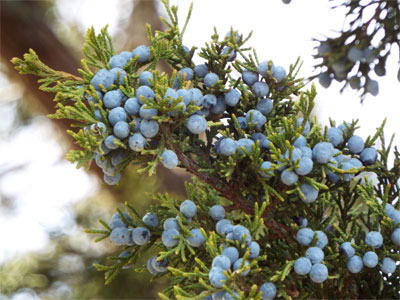
Ashe juniper or Eastern redcedar? Photos by Steven Chamblee.
by Steven Chamblee
Eastern Redcedar
So many times, the extraordinary sits so close to us that we can’t recognize it for the wonder that it is. We tend to think of remarkable things as exotic untouchables, residing far away in some magical place, where mystical people reverently cradle these treasures close to heart. Truth is, we are sitting right in the middle of miraculous every day; we need only open our minds to see it. From the intricate labyrinth of our fingerprint to our own tiny, surprised reflection in our eye’s pupil, awareness begins with small things, then grows to encompass everything else.
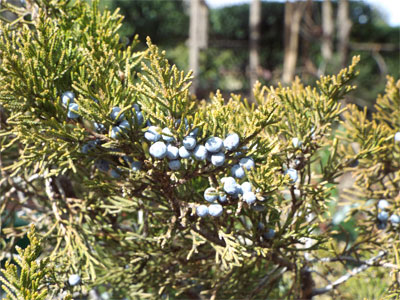
Eastern redcedar or Ashe juniper?
Headed home from work down good ol’ Garner Road, I pass by this familiar row of Eastern redcedar trees. Same trees that I’ve driven by countless times in the past eight years, only today I decide to stop and look at them. Really look. Perhaps it’s the sunlight that is just right at this moment to make them so beautiful. Perhaps it is the absence of roadside wildflowers in January. Perhaps it it the deadline for this article, looming over me like a hungry vulture. Regardless, the truck and I both become one with the bar ditch.
Eastern redcedar (Juniperus virginiana) is a widespread tree in eastern North America — and Weatherford, Texas, is just about the westernmost edge of its range. The shrub is also dioecious, meaning it has boy parts on some trees and girl parts on other trees. This old fencerow has some of each. The males have small but easily visible cone-like structures that have already opened and shed their pollen. The females are heavy with fruit — pea-sized blue “fleshy cones” that most people would call berries. But those are from last year’s pollination … where are this year’s pistils? I’ll tell you where they are. Right in front of me, but this 50-plus shades-of-gray-haired guy’s eyes aren’t what they used to be. I try to console myself with the fact that I know they are teeeeeny-tiny, but it still bums me out.
Arguably (for those who like to argue) the toughest native tree from here to the Atlantic Ocean, Eastern redcedar is found from swamps to hilltops, adapting to an amazing array of climatic conditions and ecosystems … with the notable exception of rocky, alkaline soils. And that’s just where the Ashe juniper takes over, covering the landscape to points south and west. Both form blue “berries,” both are evergreen conifers, both are called “cedar” trees, and both grow in Weatherford. They look a lot alike, but are usually differentiated by their growth habit — redcedar having a central trunk and Ashe being multi-trunked or shrub-like. BUT, there are lots of old Ashe junipers out there with straight trunks. What then?
 So I head on to the house, rolling all this over in my head until I see my dogs running the fence line … and there sits Gretchen Drew … in her new car. Gretchen is Neil Sperry’s office manager, and she has been my wife’s BFF for a long time — since before the term BFF was a good thing. She’s all smiles, and we visit for a few minutes before Patti gets home. Well, I’m no genius, but I know enough to know that the girls need to do some talkin’, so I put on my chef shorts and get busy.
So I head on to the house, rolling all this over in my head until I see my dogs running the fence line … and there sits Gretchen Drew … in her new car. Gretchen is Neil Sperry’s office manager, and she has been my wife’s BFF for a long time — since before the term BFF was a good thing. She’s all smiles, and we visit for a few minutes before Patti gets home. Well, I’m no genius, but I know enough to know that the girls need to do some talkin’, so I put on my chef shorts and get busy.
Next morning, the girls finally comment on the worried look I’m wearing. After assuring them I am not constipated (I don’t think either really believes me), I tell them this whole juniper thing is buggin’ me like a buffalo burr in my BVDs. Reference books are non-committal; the Internet info is dicey at best. Gretchen quickly assesses the situation and suggests a road trip. Now she’s my BFF! And she’s driving….
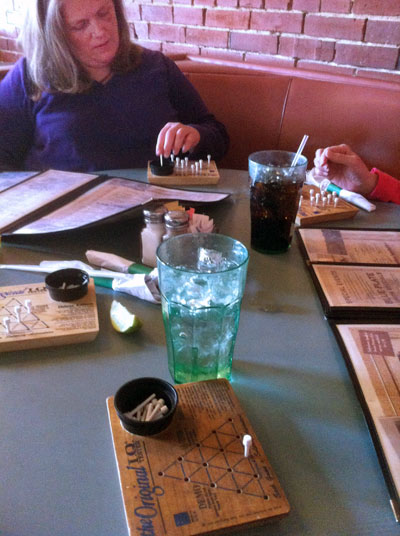
Gretchen being unimpressed by my genius at The Smokestack restaurant.
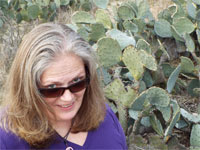
An inquisitive Gretchen checks out the prickly pear pads near Thurber.
Half an hour later, we’re on the road to The Smokestack restaurant in Thurber. The food is good, but what really blows my mind is the IQ tester game on the table. I can’t seem to lose … four games in a row down to a single peg. I begin to gloat. Fortunately, I have two ladies to ignore me completely. Nothing makes a guy feel more like a goober than celebrating without an audience.
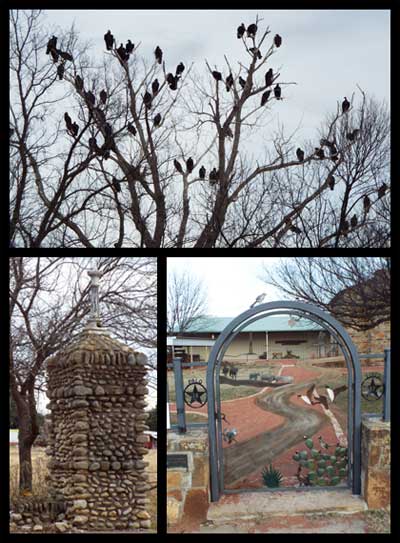
Top photo: Black vultures gather in Mingus. Bottom left photo: Amazing stone gates in Strawn. Bottom right photo: New gate to the olde village.
We’re out the door and up to Mingus, where a committee of vultures roosting in a tree reminds me of my deadline. Then it’s over to Strawn, where strange old sentinels mark the entrance to something that is no more. Cats are everywhere; and they’re smart cats, as they are all still three-dimensional. Over in Palo Pinto, we wander the square to find an Old West village of sorts, built within a Depression-era stone wall. Superbly restored old log cabins and buildings, tools and implements that built a young Texas, and even a portable prison! What a treasure to discover. A world preserved by those who chose to honor their past, instead of just letting it fade away. It’s all new to me, even though I have driven through this little town many times. It’s like a single square in the larger blanket of our nation’s history. A little something that means a lot.
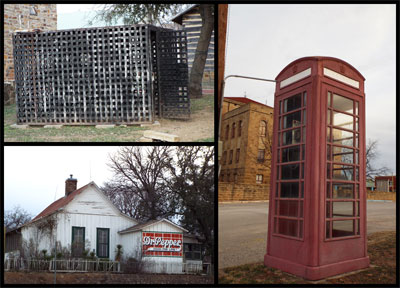
Top left photo: The portable prison. Bottom left photo: Classic Texas homestead in Palo Pinto. Right photo: Surprise! An old English telephone booth in Palo Pinto.
Hmmm … it’s all starting to gel in my head now. It’s those small details. I harvest some of the Eastern redcedar and Ashe juniper for a little head-to-head comparison, and the difference becomes clear in an instant. Fruit size and color; seed size and number; even the slight foliage difference becomes clear. All of this I can show you in the photo, but the biggest difference cannot be photographed. When any part of Eastern redcedar is cut or crushed, a clean, wonderful fragrance is released. Not so with the Ashe juniper. Its fragrance took me back about 15 years to a windy December day when I harvested my own Ashe juniper Christmas tree from a fence line out near Glen Rose. Got it installed in the house before I went to the store to get some allergy medicine and cough drops. By the time I returned, my nose was clear … clear enough to smell the delightful cat-urine scent of the juniper foliage that now filled the house!
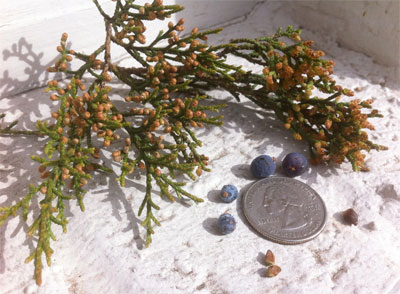
Foliage, male cones, fruit and seeds — Eastern redcedar on the left; Ashe juniper on the right.
And that, my friends, is the easiest way to tell the difference between an Eastern redcedar and an Ashe juniper.
Come visit Chandor Gardens! Go to www.chandorgardens.com for details. Just take I-20 west to exit 409, hang a right, go 2.1 miles and hang a left on Lee Avenue. Head straight 12 blocks and you’re driving in the gates. Call 817-361-1700 for more information. Winter is one of the most misunderstood times of the year at Chandor Gardens. Most people assume we sit around in comfy chairs, reveling in the “nothing to do” season. Truth is, winter is our busiest season! With visitation down and many plants dormant, this is our time to build, repair, expand, and refine the garden. Large-scale projects such as pond cleaning, stone wall repair, and large-area renovation keep us hopping! Enjoy a sunny day stroll this winter, while the “bones” of the garden are most visible. But be careful … we just might put you to work!
I can always use another road trip! Let me know if you’d like me to come out and speak to your group sometime. I’m low-maintenance, flexible, and you know I like to go just about anywhere. No city too big; no town too small. Just send me an e-mail at stevenchamblee@yahoo.com and we’ll work something out.

